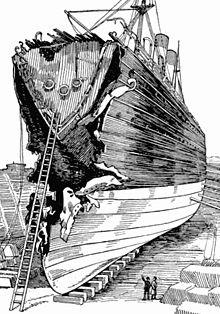Florida (ship, 1905)
|
The Florida after the collision
|
||||||||||||||||||||||||
|
||||||||||||||||||||||||
|
||||||||||||||||||||||||
|
||||||||||||||||||||||||
|
||||||||||||||||||||||||
The Florida was a passenger ship put into service in 1905 by the Italian shipping company Lloyd Italiano , which was used for passenger and freight traffic from Italy to South America and New York . She gained international fame through the collision with the British ocean liner Republic in January 1909 off Nantucket , in which six people died. The Republic sank while the Florida remained buoyant. In December 1917 she was again involved in a ship collision and this time sank herself.
The ship
The 5,018 GRT steamship was built at the Società Esercizio Bacini shipyard in Riva Trigoso near Genoa and was launched on June 22, 1905. The 116.1 meter long passenger and cargo ship was built for the Lloyd Italiano shipping company founded in Genoa in 1904 by the banker and entrepreneur Erasmo Piaggio (1845–1932) and used for their passenger and goods traffic to North and South America.

The Florida had passenger capacity for 25 passengers in the first and 1,600 in the third class ( between deck ). The ship had two funnels , two masts and two propellers and was powered by triple expansion steam engines that could accelerate the ship up to 14 knots. Her sister ships were the Indiana (4,996 GRT), the Virginia (5,181 GRT) and the Luisiana (4981 GRT), all of which were built at the same shipyard and also entered service in 1905.
On September 18, 1905, the Florida sailed from Genoa on her maiden voyage via Naples to Buenos Aires . From November 15, 1905, she operated the route from Genoa via Palermo to New York. It mainly transported European emigrants .
Collision with the Republic in 1909
In the early morning hours of January 23, 1909, the Florida was with almost 900 passengers on board under the command of 29-year-old Captain Angelo Ruspini on another crossing from Palermo to New York. On board only 13 people drove in first class, but 826 passengers in the intermediate deck . Most of them were survivors of the Messina earthquake of December 28, 1908, who decided to emigrate to the USA after losing their existence .
Due to the very thick fog, Captain Ruspini reduced the speed of his ship and had a course determined. The Florida was on a more southerly course than was actually intended for the ships entering New York. Because of the fog, the bridge watch or lookout made it difficult to see other ships. When the Republic of the British White Star Line emerged from the fog about 50 nautical miles off Nantucket , it steered directly in front of the bow of the Florida . The Republic immediately dodged to starboard ; the Florida turned to port.
Despite both maneuvers, the collision could not be prevented and the collision occurred at around 5:40 a.m. Florida's bow bored into the Republic's port side , about midships level with the engine room . Their engine room was flooded immediately, so that control and electricity supply failed within a short time. With the reserve batteries, Republic radio operator Jack Binns was able to use spark telegraphy to send an " FT emergency call " with the Morse code CQD - the character string SOS was only established later - and thus request help. It was the first time in the history of shipping that a ship in distress made this emergency call using the new communication technology of maritime radio .
Three crew members perished in the heavily indented forecastle of the Florida : 14-year-old cabin boy Salvatore D'Amico, 16-year-old sailor Balogero Martuscilli and 23-year-old sailor Pasquale La Vallu. Three passengers died in the collision area on the Republic .
The Republic's passengers were initially transferred to the Florida , which was quickly overloaded. When the much larger White Star steamer Baltic arrived at the collision point, she took the passengers of both ships on board and brought them to New York. Pulled by two tugs , the Florida arrived in New York three days later in the early morning of January 26th. Immediately after docking, Count Annibale Raybaudi-Massiglia , the Italian consul general in New York, boarded the ship and found out about the situation.
To this day, this rescue operation is one of the largest person transfers that have ever taken place on the open sea.
Late years
On April 20, 1911, the Florida ran out on its last voyage on the Genoa – Palermo – Naples – New York route. Their first class accommodations have been downgraded to second class. In the same year she was sold to the shipping company Ligure Brasiliana, also based in Genoa and founded in 1897, which she renamed Cavour and used for its South American services.
In 1914 the ship went to the Transatlantica Italiana Società Anonima di Navigazione. On December 12, 1917, the ship collided in the Mediterranean north of Cape Tortosa and about 30 nautical miles from L'Ametlla de Mar on the Costa Daurada with the Italian auxiliary cruiser Caprera and sank. There were no fatalities.
